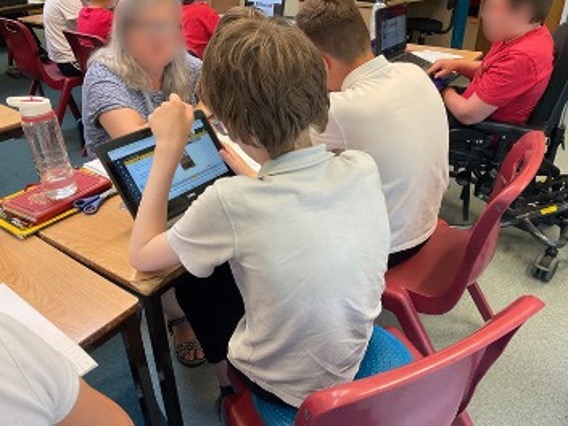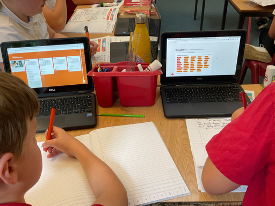Lesson Commentary
Writing a strong opening sentence
Immediately after Activity 3, the children excitedly start their writing. Several Chromebooks are opened up on the desks, and children all talk to one-another about their stories.
The teacher begins by asking for an example of an opening sentence, and several children volunteer and present their ideas for an opening sentence. Other children nod in agreement when a child reads their sentence and the teacher encourages the children through the use of ‘lovely opening’ and ‘very good’.
There is a strong sense of productivity and encouragement at this point in the lesson. Children are keen to share ideas, and seem keen to start their stories. The teacher sets out an atmosphere of support and encouragement, in which all ideas are worth exploring and expanding upon.
Writing the beginning of the story in their writing books with pen or using ScribEasy
There is a buzz of activity in the classroom, with children starting to open up their writing books and their Chromebooks. One of the children opens a thesaurus on her Chromebook and starts looking at various synonyms. Some children begin talking to one-another, sharing a Chromebook screen between them. Others are fetching their Chromebooks from their laptop bags.
The Chromebooks are used as a reminder of the story, with children moving between the various Padlets. Several children put up the story exemplar that the teacher referred to in Activity 3.
Three children with SEND use ScribeEasy to write their stories, and the TA is helping them, providing explanations, ideas and encouragement. They are very engaged with their stories, and work in a very similar way to the rest of the class, although they write their stories on their Chromebooks, rather than on pen and paper. They do talk together to share ideas, and occasionally show things to one-another or to the teacher or TA.

Writing the story using Scribeasy with the help of the TA
Children using pens, paper and their Chromebooks, shift their focus between various digital resources and their pen and paper-based task. Some children are occasionally looking at the IWB and nearly all children have one of the various resources open on their Chromebooks. They also occasionally listen in to the teacher, who is walking around the classroom and helping individual children.
While some children immediately set out to write their story, others peruse the resources first. It is clear that the Padlets are used as an aide-memoir continuously, as they help to remind the children of the time structure of the story and tense, and the narrative structure through the description of characters.

Sharing of digital resources to support pen and paper writing task
Observations about enjoyment and engagement
Children are focused and engaged with the activity throughout and were keen to start writing the beginnings of their stories. They often switch between the various Padlets and the film and use the resources to help structure the narrative and propel their writing. The share the various screens between them in small groups and this informal collaborative action is helping to support writing as a communicative activity, in a community of writers.
